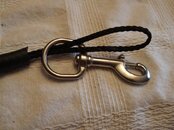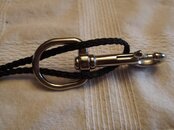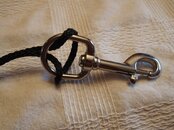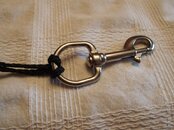2airishuman
Contributor
I've re-rigged some of my stage bottles incorporating suggestions received here and my own ideas.
I use #72 waxed, braided nylon cord. It's heavier than the cave line usually used for stage rigging, and holds knots a little better because of the waxed finish. Available from many sources, I got mine here, the 195 feet per pound size:
https://www.amazon.com/gp/product/B00BN37VWI
This allows the handle to be made strong enough that it can be used above the water.

For each stage bottle, the materials needed are:
- #72 cord, about 6 feet
- two bolt snaps, one medium, one small. For larger stages, both bolt snaps can optionally be medium.
- a length of 5/16" fuel line hose, for the handle, about an 18" long piece.
- stainless steel band clamp sized to go around the cylinder. I try to find the ones that are all stainless steel, as the ones with a carbon steel worm gear will rust.
- Nylon sleeve, to go over the clamp to prevent dissimilar metal corrosion or paint damage to the cylinder. Optional for galvanized cylinders. Or, a piece of inner tube to go under the clamp.
- Heat shrink tubing to go over the screw portion of the clamp, to reduce the entanglement hazard.
- Bungee cord, about 18", for the neck ring. I use the heavier of the two styles DGX sells.
In addition to basic tools, you'll need something to help thread the cord through the fuel line. I use smaller cord, but a coathanger would also work.
The first step is to make a loop of the #72 cord and pull it through the fuel line:

Then attach a medium bolt snap using a lark's foot knot:




I use #72 waxed, braided nylon cord. It's heavier than the cave line usually used for stage rigging, and holds knots a little better because of the waxed finish. Available from many sources, I got mine here, the 195 feet per pound size:
https://www.amazon.com/gp/product/B00BN37VWI
This allows the handle to be made strong enough that it can be used above the water.
For each stage bottle, the materials needed are:
- #72 cord, about 6 feet
- two bolt snaps, one medium, one small. For larger stages, both bolt snaps can optionally be medium.
- a length of 5/16" fuel line hose, for the handle, about an 18" long piece.
- stainless steel band clamp sized to go around the cylinder. I try to find the ones that are all stainless steel, as the ones with a carbon steel worm gear will rust.
- Nylon sleeve, to go over the clamp to prevent dissimilar metal corrosion or paint damage to the cylinder. Optional for galvanized cylinders. Or, a piece of inner tube to go under the clamp.
- Heat shrink tubing to go over the screw portion of the clamp, to reduce the entanglement hazard.
- Bungee cord, about 18", for the neck ring. I use the heavier of the two styles DGX sells.
In addition to basic tools, you'll need something to help thread the cord through the fuel line. I use smaller cord, but a coathanger would also work.
The first step is to make a loop of the #72 cord and pull it through the fuel line:
Then attach a medium bolt snap using a lark's foot knot:








